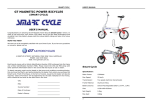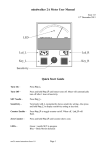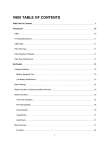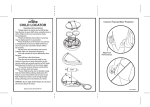Download SUUNTO t6 TEAM PACK
Transcript
SUUNTO t6 TEAM PACK BRIEF INTRODUCTION FOR COACHES CONTENTS OF THE SUUNTO t6 TEAM PACK 10 heart rate transmitter belts numbered 1-10 10 Suunto t6’s numbered 1-10 11 Datasnakes for downloading data from Suunto t6’s – one for each athlete and one for the coach 10 CD’s with Suunto t6 manual and Suunto Training Manager PC software for personal use Replacement batteries for Suunto t6’s and heart rate transmitter belts Suunto t6 Team Pack also includes: - Team Pack introduction sheet - Suunto Training Manager introduction card - 10 Quick Guides - Suunto t6 towel (short printed user manual for drying the transmitter in 8 languages) belts after use - 3 Training Guidebooks 1 CD with Suunto Team Manager PC software for the coach SETTING UP COACH AND ATHLETE PROFILES IN THE SUUNTO TEAM MANAGER PC SOFTWARE To install the Suunto Team Manager, follow the instructions on the CD or in the Quick Guide. Following steps ensure accurate analysis of the training logs. 1. Right-click the coach icon . Adjust the coach settings and create the list of activities. 2. Create personal profiles for all athletes under the Team menu. Set the required personal data for the athlete. 3. Right-click the athlete icon . Open the Personal page and adjust the estimated Max HR and Rest HR, METS, Max respiratory rate, Max ventilation and Vital capacity if you know measured values for these. This will further improve the accuracy of the analysis. The underlined measures are especially important. Coach settings Athlete’s personal profile Note: METS = VO2max in ml/kg/min divided by 3.5. Note: When downloading training logs, pay attention to transfering them under the right athlete to have them analyzed with the individual’s data. ANALYZING INDIVIDUAL ATHLETE’S TRAINING SINGLE WORKOUT From every workout recorded with Suunto t6 the software provides an analysis with graphs, summary values, and numeric data of seven body parameters: - Heart rate tells the training intensity throughout the workout. - EPOC* and Training effect EPOC indicates the accumulated physiological load of the workout. Training effect relates it to the personal performance level, telling the effect of the session on the athlete’s condition with a scale of 1-5. - Ventilation volume and Respiratory rate tell about the respiratory system’s work during the excercise. - Oxygen consumption (VO2) is the instant oxygen consumption during the workout. - Energy consumption shows how much calories the athlete consumed at any moment of the workout. *EPOC = Excess Post-Exercise Oxygen Consumption Heart Rate EPOC + Training Effect VO2 Respiration Energy Consumption TRAINING LOGBOOK Training logbook gives an overview of an athlete’s training over a selected period of time. It helps to: - Find the ideal training load for the athlete to optimize results. - Include enough variation in training. - Identify training sessions that require more recovery. - Avoid the risk of overtraining by visualizing periods of high intensity training. ANALYZING TEAM TRAINING TRAINING STATUS OVERVIEW The training status spreadsheet provides you with the tools to analyze at a glance the performance of the whole team over a longer period of time. 1. Open the calendar and select the time period to analyze. 2. Select the athletes you want to review from the list. 3. Select the parameters in which you are interested. 4. The software creates a report over the selected period of time. 5. Print the report for handouts and feedback to the athletes or for the team’s training logbook. COMPARING INDIVIDUAL WORKOUTS Layering several athletes’ graphs from a particular workout shows how they performed during the workout. This gives you valuable information to adjust each athlete’s training program for the best possible progress. 1. Select the training logs under each athlete’s name or from the calendar. 2. Press the Graph button. 3. Print for handing out feedback to athletes or sharing with other coaches. PRACTICAL TIPS 1. USING SUUNTO t6 DURING TRAINING 1. Put on your HR transmitter belt and ensure it fits snugly against your chest. 2. Ensure the electrodes of the transmitter belt are lightly wet. 3. Switch on the heart rate reception of your Suunto t6. 4. If you want to use timers or HR limits, activate them in the Training mode. 5. Start recording your training by pressing START/STOP in the Training mode. When the stopwatch is on, you can take lap times with UP/LAP and switch between modes with DOWN/LIGHT. 6. Stop the training by pressing START/STOP. 7. Connect the Suunto t6 to PC with the Datasnake. 8. Download and analyze the recorded data in the Suunto Training Manager PC software. 3. 5.-6. KEEP THE NUMBERED SETS TOGETHER The Suunto t6 wrist units and heart rate transmitter belts are individually paired to each other to eliminate cross talk. The wrist unit only receives heart rate from the belt it is paired with. The paired sets are indicated with numbers 1-10. Make sure that you always distribute matching parts. If needed, the wrist units and belts can be paired again following the instructions in the Quick Guide. Suunto Bike POD turns your Suunto t6 into a wireless BIKE COMPUTER. It is easy and secure to attach to the front hub. www.suunto.com Suunto PC POD enables real time training analysis with the future versions of the Suunto Training Manager. All Suunto products are subject to change without notice. Suunto Foot POD is the lightest, most practical and most reliable speed and distance sensor available for RUNNING. Feather light and firmly clipping to shoe without untying laces, it is virtually unnoticeable when running. © Suunto Oy 1/2005 EXTEND THE FUNCTIONALITY OF THE SUUNTO t6 WITH WIRELESS ACCESSORIES.

















